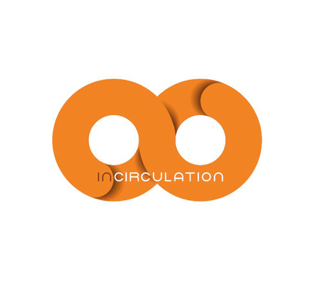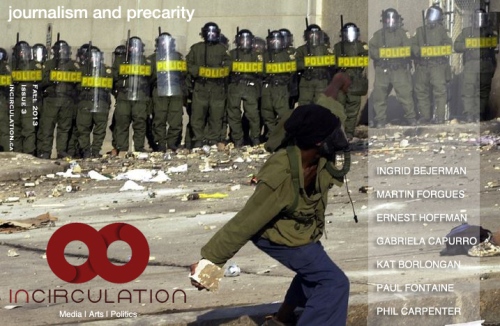
IN CIRCULATION Media | Arts | Politics
Department of Art History & Communication Studies, McGill University
http://www.incirculation.ca
Issue 4, Vol. 1: To Participate: Global and Spatial Perspectives
Call for Papers
and Artworks
Deadline for submission:
EXTENDED June 25, 2014
What is participation? Who can participate and who cannot? Why participate? What is the role and what are the limits of technologies and platforms to contemporary forms of participation? What strategies and forms of collaboration are deployed to draw attention to or trouble conventions of gender, race, or faith? These questions are increasingly profiled and addressed in academic fields, art production, popular culture, and the media.
The Participatory Condition, for instance, an international colloquium hosted by Media@McGill in November 2013, was devoted to discussing such questions, and included a Participatory, Open, Online Course (or POOC). This issue of In Circulation is intended as a reply to this colloquium, and will add to the discussions it featured.
Models of participation are particular to local contexts, but often have consequences that extend to the global. Recent events such as the Arab Spring, the Occupy movement, and the interventions of Anonymous give evidence of calls for participation, and also pose geopolitically specific questions about the nature of participation. In Quebec at the moment, the question of political participation seems especially fraught because of events like the provincial student strike of 2012, when thousands of students and other citizens gathered to speak out against proposed tuition increases. Students organized protests and gained leverage for the movement using social media, but also employed significantly lower- tech strategies of participation including marches during which protestors would bang on pots, pans and casseroles. This issue of In Circulation aims to analyze within –and propose beyond – these frameworks. We are especially interested in how social networks function in contexts such as Africa, Asia, Latin America, Eastern Europe, and the Middle East.
This interdisciplinary issue will focus on contributions from Art History and Communication Studies. It will give attention not only to objects of study that are participatory, but also to the range of participatory models active in research today – whether through interdisciplinarity or cross-cultural exchanges and collaborative research projects, particularly those engaging global perspectives.
Authors are encouraged to pursue the political climates, economic conditions, and understandings of community that have buttressed specific ways of participating, whether through media or artworks. Possible themes for papers could include the history of participation in art and communication and more recent trends such as social media, video games, interactive art, and issues of surveillance, politics and democracy. Other possible directions for contributions include the participatory impulse in relation to cyber-feminism, visual studies, and postcolonial theories in an effort to examine hegemonic flows of participation across nations, as well as within nations and communities and to move beyond dominant geographies of contemporary discussions of participation and seeking a broad ethnic diversity in contributors and frameworks.
There are contemporary forms of participation in art and media that seek to disrupt the participatory model by calling into question celebratory claims: in art history, participation has been approached as a strategy of the avant-garde used to disrupt complacency and work against the alienation apparent in modernity (Bourriaud) or to enact democracy and seemingly deeper forms of community (Bishop, Kester, Felshin, Lippard). Multisensory participatory experiences have also been theorized, putting stress on their political and cultural value, often to tease out their phenomenological workings (Drobnick, Fisher), their political and economic contexts (Canclini, Howes, Mosquera), and their orientation with respect to gender (Ahmed). Frameworks that trace the history of the very notion of participation and participatory cultures are also extensive (Carpentier, Delwiche, Henderson, Jenkins). Recent discussions have investigated the relations between participation, power, and democracy (Crawford, Barney), while others have questioned the assumption that participation is good in itself and have addressed issues of class, gender and race (Nakamura, Sterne). There are also formulations arguing for different forms of abstention or refusal to participate (Jurgenson, Portwood-Stacer).
Possible subjects for papers may include, but are not limited to:
– modes of journalism and reportage, either via conventional formats such as newspapers, or the voluntary self exposure of blogging, tweeting, and Facebook; as well as the strategies of reality television that encourage popular voting, and the promise of celebrity for everyday people
– curatorial and institutional approaches to commissioning temporary or public art projects from artists that instigate community engagement and collaboration
– video games; massively multiplayer online gaming
– geospatial focuses of global art histories; internationally oriented research networks that invite
collaboration between scholars
– methods of activism that adapt forms of theatre, art, and music and vice versa
– institutional and governmental stewardship and funding of participatory practices
– models of participatory pedagogy.
In an effort to continue and move beyond the discussion that took place in Montreal last November 2013, this special issue on Participation will have a section dealing with Media@McGill’s International Colloquium on The Participatory Condition. Collaborative papers in response to the different sessions and/or to the Participatory, Open, Online Course (POOC) component are also welcome. (See http://www.pcond.ca and http://www.pcond.ca/pooc)
In Circulation is an interdisciplinary journal as such, we invite proposals from scholars, artists, researchers working in but not limited to: Communication Studies, Art History, Cultural Studies, English, Museum Studies, Library Sciences, History, and Philosophy.
Papers can be in English or French, and should include a 250-word abstract. Submissions should
be in Chicago Style, and be formatted for blind review. We will accept .docx, .doc, or .rtf only. We accept both short pieces and longer articles, not to exceed 6,000 words. We also encourage art, multimedia or opinion-based submissions. Authors are responsible for clearing all copyright.
Examples of media/formats include: audio and electronic art, bio art, digital storytelling, game art, net art, open source and community-based practices, radio art, video art, short film, documentation of public interventions, performance and interdisciplinary practices.
In Circulation Issue 4, Vol. 1: To Participate: Global and Spatial Perspectives will be launched at Studio XX in the Fall 2014 and it will be accompanied by an exhibition featuring selected artworks.
Please send your submissions as an e-mail attachment to incirculation@gmail.com by May 30, 2014.
Any questions or inquiries should be sent to:
Guest Editors:
Mark Clintberg: mark.clintberg@gmail.com
Erandy Vergara: erandy.vergara-vargas@mail.mcgill.ca
Editorial Team:
Cheryl Thompson: cheryl.thompson@mail.mcgill.ca
Joseph Sannicandro: thenewobjective@gmail.co
http://www.incirculation.ca


 My first words with El Maestro, as he is known across Latin America, were by telephone: a surprise job interview set up by Jaime Abello Banfi, who directs the Foundation for a New Ibero-American Journalism (FNPI), founded and chaired by Gabo to, as he put it, “take a break from academic training, and return to a primary system of practical workshops in small groups.”
My first words with El Maestro, as he is known across Latin America, were by telephone: a surprise job interview set up by Jaime Abello Banfi, who directs the Foundation for a New Ibero-American Journalism (FNPI), founded and chaired by Gabo to, as he put it, “take a break from academic training, and return to a primary system of practical workshops in small groups.”





